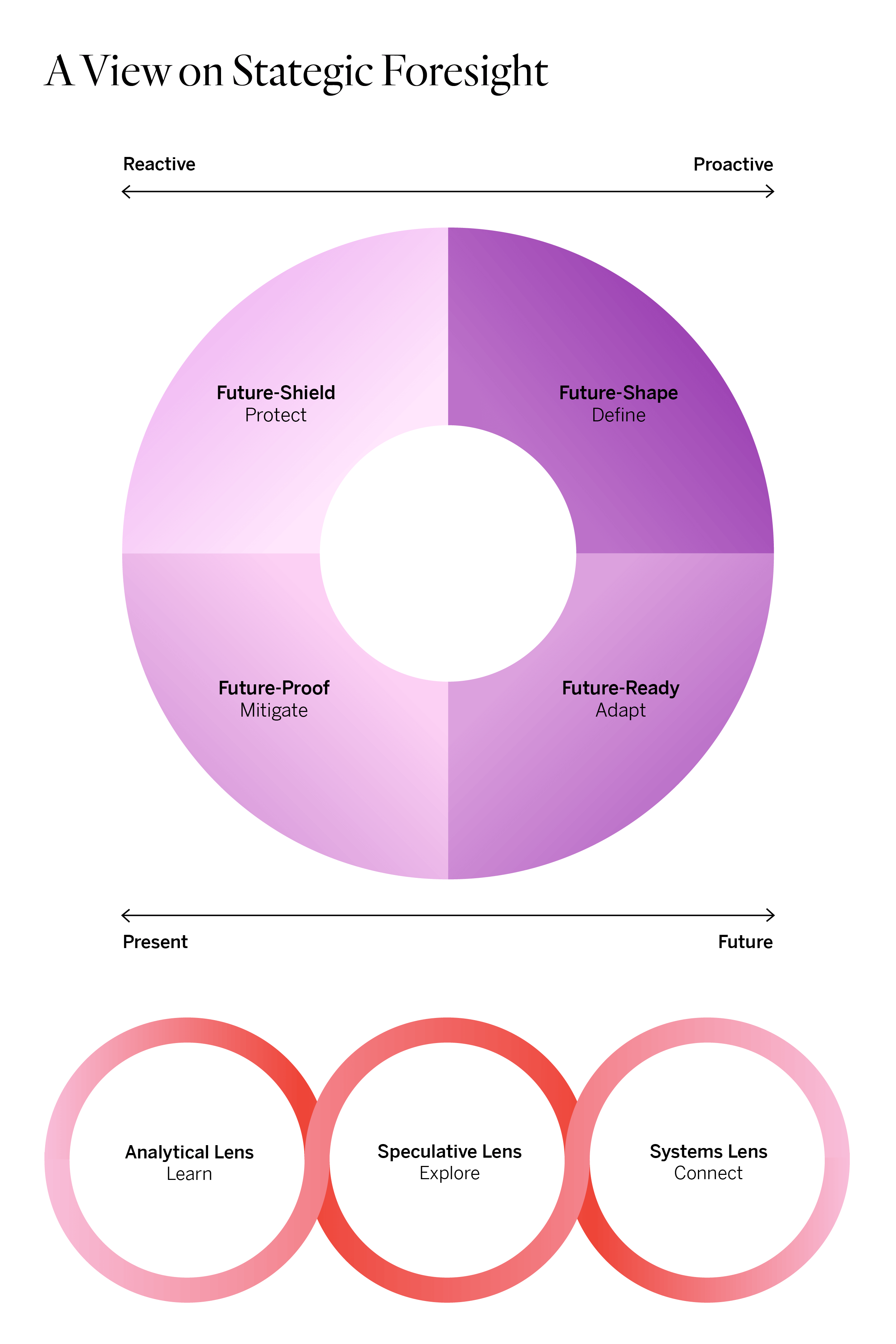
Realizing Visions of the Future Through Strategic Foresight
Adapting to twists in the path
It’s a story that has been told many times over: Kodak’s journey from global photography giant to bankruptcy in the era of digital photography. The narrative usually plays out as a cautionary tale. Once upon a time, an incumbent failed to innovate and lost out to technically savvy new entrants. However, this misses an interesting subplot.
Between 1974 and 2006, Kodak had a nuclear reactor loaded with 3.5 pounds of enriched uranium in a secret underground laboratory in Rochester, New York. The reactor, which was used to perform neutron radiography testing, was an investment in cutting-edge technological research. This should have kept Kodak at the forefront of new photography and imaging products. But we all know what happened next: Kodak found themselves blindsided by new developments in digital photography and unfairly labeled laggards.
For many executives and organizations, with today’s backdrop of accelerating technological convergence, the climate crisis and wider societal and systemic shifts, it can feel like one moment of inertia or strategic misstep could lead to obsolescence, or even becoming the next cautionary tale. The challenge lies not just in the ability to adapt to profound transformation driven by new technologies and elevated data literacy, but also in finding ways to proactively contribute toward a better future.
To make your mark, it is vital to carve out a path that’s innovative, resilient and adaptable in the face of relentless change and complexity. Continuous business reinvention is key: imagining what’s next and creating a brand-new business model, product or service. This requires answering the big questions. These might include: How do you safeguard the integrity of your brand in an era where GenAI-enabled bots mediate the relationship between you and your customer? How do you maintain a competitive edge in a market where consumer expectations are increasingly defined by sustainable practices and a robust ethical footprint? What are the first steps you can take to turn your future vision into present reality?
Realizing strategy as a creative act
Strategic foresight is a discipline and mindset that equips organizations to effectively anticipate and navigate future uncertainties. Strategic foresight offers a springboard for businesses to continuously reinvent themselves, ensuring that their strategies are responsive to myriad forces impacting the market landscape. After all, the ability to anticipate future shifts is only as valuable as your organization’s capacity to reinvent itself in accordance with these insights.
A mainstay of business strategy for decades, strategic foresight has manifested in various forms, from scenario planning to adaptive strategy development. Central to its philosophy is the understanding that the path ahead is neither linear nor predictable—necessitating a culture of adaptability to be prepared for the onset of multiple possible futures. Here at frog, we use futurecasting to help clients—including the Associated Press and the United Nations—imagine possible futures and act accordingly.
Fundamentally, strategy is about creating choices, navigating through challenges and seizing emerging opportunities. It requires a multifaceted approach that breaks the shackles of conventional thinking. At frog, we view strategy as a creative act—a product of human imagination, curiosity and intuition that shares a symbiotic relationship with design, data and technology. Strategy provides direction, design shapes the path, data informs approach and technology enables execution.
The empirical perspective traditionally favored by consulting tends to prioritize quantitative analysis and data-driven insights. While this approach has its merits and provides valuable information, it must be used in conjunction with other methods to capture the more nuanced, qualitative dimensions of strategic challenges and opportunities. The future cannot be captured in a spreadsheet: it is a living, breathing landscape of myriad possibilities.
When used successfully, strategic foresight can lead to opportunities and alignment across various aspects of the business and for different scales. Here are just a few examples.
- Launch new businesses and make bolder choices based on real-time needs
- Transform brands, moving the organization into innovative, hyper-relevant positioning
- Realize connected product and service experiences that push the boundaries of the possible
- Uncover new ways to deepen engagement and elevate loyalty with customers
- Identify the essential capabilities required to future-proof your organization
Mapping the strategic paradigms of futures thinking
Each organization—depending on its unique context, culture and circumstances—develops a distinct relationship with the future that profoundly influences how it perceives and prepares for what lies ahead. At different times, and in different contexts, the future might be perceived as a threat, an opportunity or something malleable that can be shaped to a strong vision. Through working with clients, we’ve identified the four main categories of strategic foresight.
Future-Shield
Protecting from further impact of adverse and unanticipated events
When an organization must adapt retrospectively just to survive, we call it “future-shielding.” This is not necessarily a result of ineptitude. Life isn’t always predictable and sometimes, we form strong and knowledgeable convictions of what is likely to transpire and end up being wrong. The challenge in this context is to pivot and adapt to the new reality that has emerged, while minimizing potential damage to people, product, revenues and brand.
At frog, over five decades, we have witnessed numerous such challenges across a multitude of sectors. Against the backdrop of rapidly changing media consumption and an evolving industry landscape, we helped one of the largest non-profit news agencies identify and navigate upcoming challenges and potential opportunities. We also worked with a major computer hardware manufacturer to revive the at-risk inkjet printer category with innovative product concepts. Using a combination of Gen Z research and futures thinking, frog created a vision that was embraced by the client and helped them find their new niche.
Future-Proof
Mitigating risk to existing plans based on expected outcomes
“Future-proofing” essentially refers to a series of strategic activities that companies can take to prepare themselves for the potential negative impact of future events. Utilizing elements from risk management, future-proofing is a defensive position, where reactions to individual events can be detected and tackled with a series of actions that anticipate impact. This is usually the domain of large, mature incumbents with a million moving parts that need time, space and a plan to maneuver themselves in-case “things go south.”
At frog, we recently used this approach to help a global leader in air traffic control and airport performance drive bottom-up change and think of the unthinkable. Understanding the evolution of their role in the context of new modes of mobility helped them develop an ambidextrous approach where they began to inculcate divergent strategic thinking while continuing to incrementally improve their core business activities.
Future-Ready
Adapting to change by monitoring and analyzing new opportunities
“Future-ready” organizations look at the future from an adaptive and anticipative standpoint, positioning themselves to take advantage of new opportunities as they appear. This approach moves away from a deterministic methodology and into the realm of plausibility, asking “what could potentially happen?” instead of “what is likely to happen?”
Envisioning plausible futures helps craft an inherently flexible strategy. Along with a core approach, a series of contingent pathways can be activated should things proceed differently than anticipated. For instance, frog was commissioned by one of the largest tech companies in the world to envision how the metaverse will impact human life over the next decade. The program asked for divergent yet convincing narratives and a clear long-term strategy that enables them to find their spot in this emergent ecosystem.
Future-Shape
Defining new business and culture shifts and assessing threats proactively
Companies that “future-shape” usually have strong internal convictions and aim to take the lead on defining what the future looks like. They generally tend to buck the herd mentality prevalent within the sector. While some may perceive future-shaping as “risky” or “ambitious,” the payoffs are potentially huge—it indicates to the wider ecosystem where you believe the most value can be delivered. This approach is somewhat idealistic in its nature and requires that organizations define a clear vision, ambition and pathway to not only bring this idea into reality but shape the perception of stakeholders and bring them onboard. It’s an approach aimed at shaping the systems and environment around you to build the future you want.
More recently, one of the largest infrastructure conglomerates in the world challenged frog to develop flexible, adaptive and contingent strategies to help position them as key players in the future of mobility and energy storage. The initiative tied their long-term corporate intent to a set of ambitious, yet practical activities that generated an immense, immediate impact for them. New business lines, strategic alliances and a future-oriented organizational mindset positioned our client as one of the most innovative companies in their domain within a matter of years.
Applying different lenses to strategic foresight
To harness the full potential of strategic foresight, organizations must embrace a variety of lenses to think about the future, ensuring they remain agile and adaptable in the face of uncertainty. Unfortunately, a universal formula doesn’t exist, since this is determined by a multitude of forces shaping a company’s internal and external context. In general terms, there are three lenses that we apply at frog when thinking about the future. The key is to decide which approach (or combination of approaches) is right for you.

Analytical Lens
Learning from historical data to inform and guide future-oriented decisions
Leveraging the Analytical Lens entails historical extrapolation to derive informed opinions about the future. You can usually analyze tons of information and create compelling, content-heavy opinions that might potentially withstand scrutiny of past events to develop best practices and avoid potential pitfalls. However, when used alone, this type of thinking is inherently reductionist as opinions on the future are rooted in past events. If the future ceases to follow convention, this approach can become counterproductive.
Speculative Lens
Exploring a wide array of future possibilities with creative and divergent thinking
Conversely, we have the Speculative Lens. By speculating on an individual topic’s variables and events and describing them holistically, organizations can encourage thinking outside of the box, capture divergent perspectives and incubate controlled and constructive friction. For example, at frog we collaborated with wearable tech brand MACHINA to imagine fashion as survival in the face of climate crisis. This approach utilizes tools such as brainstorming sessions, brainwriting and wildcards. However, preparation and alignment on the tools and processes used for speculation is important for this method to produce successful results. These sorts of generative exercises are useful but must be considered at a deeper level to have lasting value. “Two-minute futures” designed over the course of a couple of workshops could risk superficiality and potentially fail to withstand in-depth examination, providing limited value for an organization.
Systems Lens
Connecting across systems to build flexible and adaptive strategies
Finally, the Systems Lens uses a suite of tools to explore the gray area between either end of the spectrum, applying design principles to strategy and innovation. It entails the use of logic, imagination, intuition and systems thinking to explore the possibilities of “what could be” and to create desired future outcomes. By thinking about the interconnections and causality between different variables, exploring feedback loops and weak signals and synthesizing the insights derived from the analysis, organizations can obtain a deep and thorough understanding of the world around them.
Shaping new realities and possible futures
Returning to our protagonist from the beginning of the story, Kodak was able to adapt and reinvent itself. Today, Kodak is recognized as a pioneer that revolutionized photography and still leading in new ways—recently building entirely new IMAX film stock for Christopher Nolan’s 2023 movie, Oppenheimer. Kodak’s journey serves as a vital lesson for other corporations: even industry giants are not immune to the tides of change. And in today’s era of accelerating, unabated and discontinuous change, it’s worth questioning: how might organizations proactively identify and integrate emerging developments and market shifts, rather than being outpaced by them?
Ultimately, the organizations setting themselves up for success are the ones who dedicate time, resources and energy to imaginative and rigorous explorations of possible futures. Remember, as humans, our perception of reality is often anchored in cognitive biases, deeply ingrained mental models and subjective opinions of the past. Acknowledging this and having a structured reflection on what may be around the corner enables change that resonates across the cultural fabric of your organization and helps escape the “business as usual” mindset. Ask yourself: How is your organization preparing for the unknown? Are you simply following the well-trodden path, or are you ready to forge a new one?
Want to learn more about strategic foresight? Check out our latest article, Reframing Strategic Foresight in the Age of AI & Algorithms, to find out how some of the latest developments in AI are forever altering the landscape of futures thinking.

Octavio Egea is a Vice President and Head of Innovation, Strategy & Design at frog. For 20+ years, Octavio has been helping organizations decipher, navigate and thrive in complex industry contexts, deploy new growth platforms and embrace innovation to drive superior alpha. He leads a team of passionate strategists, designers and technologists assisting startups and global corporations in identifying emerging opportunities, developing growth strategies, building new businesses and creating innovative and meaningful experiences that resonate with customers and employees.

As an Associate Strategy Director, Arjun specializes in empowering clients to unlock their growth potential and achieve profitability amidst a dynamic and uncertain business landscape. Driven by a passion for cultivating long-term, scalable success, he works closely with organizations, teams and individuals, helping them enhance their capabilities and adapt to complexity and change with confidence. Arjun’s expertise encompasses strategic foresight, product & innovation strategy and creative problem-solving, enabling him to not just identify opportunities but see them through to fruition, driving growth and delivering tangible impact for his clients.
We respect your privacy
We use Cookies to improve your experience on our website. They help us to improve site performance, present you relevant advertising and enable you to share content in social media. You may accept all Cookies, or choose to manage them individually. You can change your settings at any time by clicking Cookie Settings available in the footer of every page. For more information related to the Cookies, please visit our Cookie Policy.


